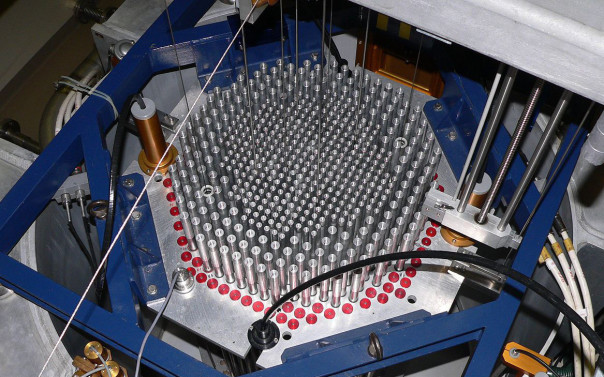Hello! As a reader of this blog right now you are currently using some form of electricity to power your computer, tablet, or any one of your cool gadgets that you use to browse the internet. You must wonder, where does this electricity come from and what does it look like? Unfortunately I cannot show you what it looks like but I can show you where it comes from and you will be amazed at what you see!
 |
| An aerial photograph of a nuclear power plant. |
Check out that picture on the right. Those massive cement cylinders that you see releasing white gas are a fascinating sight and look pretty intimidating!
What if I told you that there is a very good chance that those cement towers are the reason why you are reading this blog? Well there is a good chance they are, and the structures that you see here make up what is called a nuclear power plant! A nuclear power plant is, and try to stay with me here, a facility that uses fuel called uranium which heats up water to produce steam that spins a turbine and creates electricity (nuclear-energy.net). Although it may sound confusing, it is actually fairly simple to understand so lets take a tour through a nuclear power plant so I can show you some of the cool gadgets that power this thing!
 |
| The control rods of a nuclear power plant. |
First off, we will take a very important part of the insider of the nuclear power plant called the control rods. The control rods are seen in the picture to the left, and they are very important! They are responsible for controlling how much fuel goes in at a time so the plant can run as smoothly as possible to get you the electricity that you need (1). Those look pretty cool, right?
.jpg) |
| A photo of a pressure vessel being placed inside of a nuclear power plant. |
Next we will take a look at what is called the pressure vessel, which is shown in the picture to the right. The pressure vessel holds the fuel, uranium, which powers the nuclear power plant and it is in charge of keeping the uranium inside of the power plant so it does not leak. We do not want uranium leaking it out because it is dangerous since it is radioactive, and something that is radioactive can harm the cells in your body (3).
Dangerous? Why would we produce electricity from something that is dangerous? We do it because we keep it safely within a containment structure which is built to seal the uranium inside and protect those outside from the effects (1). A detailed diagram of the containment structure is shown below, which shows just how strong the structure is!
 |
| A diagram detailing the sheer strength of the containment structure. |
 |
| A picture of a steam generator inside of a nuclear power plant. |
One last thing to show you, then I will tell you some cool facts about nuclear power to close out! See that thing to the right? That is called the steam generator. The steam generator is responsible for producing the steam that turns the turbine that produces electricity (1). Without the steam generator, there would be no power and no cool looking clouds that come out of the nuclear power plant!
Hopefully this little tour gave you a nice idea of what a nuclear power plant is and how it works, but I'm sure you are wondering how much pollution a nuclear power plant makes. To answer your question, a nuclear power plant actually does not emit any pollution and has one of the smallest impacts on the environment out of any energy source (4)! To further soothe your fears, there are right now 440 nuclear power plants in the world (5) and provide nearly 20% of the electricity here in the United States (6)! We are still alive, right? Yes! Because if we were not, we would not be reading this right now and we would not be able to tell our friends all the cool things we learned about nuclear power!
References
1. World Nuclear Association. (2017, February). Nuclear power reactors. Retrieved from
http://www.world-nuclear.org/information-library/nuclear-fuel-cycle/nuclear-power-
reactors/nuclear-power-reactors.aspx
2. U.S. Nuclear Regulatory Commission. (2016, February). Backgrounder on reactor pressure vessel
issues. Retrieved from https://www.nrc.gov/reading-rm/doc-collections/fact-sheets/prv.html
3. BBC. (2014). Safe use and handling of radioactive materials. Retrieved from
http://www.bbc.co.uk/schools/gcsebitesize/science/add_ocr_21c/radioactive_materials/safe
handlingrev3.shtml
4. Nuclear Energy Institute. (n.d.) Protecting the environment. Retrieved from
https://www.nei.org/Issues-Policy/Protecting-the-Environment
5. World Nuclear Association. (2017, January). Nuclear Power in the World Today. Retrieved from
http://www.world-nuclear.org/information-library/current-and-future-generation/nuclear-power
-in-the-world-today.aspx
6. Nuclear Energy Institute. (2016). General U.S. Nuclear Info. Retrieved from
https://www.nei.org/Knowledge-Center/Nuclear-Statistics/US-Nuclear-Power-Plants
http://www.world-nuclear.org/information-library/nuclear-fuel-cycle/nuclear-power-
reactors/nuclear-power-reactors.aspx
2. U.S. Nuclear Regulatory Commission. (2016, February). Backgrounder on reactor pressure vessel
issues. Retrieved from https://www.nrc.gov/reading-rm/doc-collections/fact-sheets/prv.html
3. BBC. (2014). Safe use and handling of radioactive materials. Retrieved from
http://www.bbc.co.uk/schools/gcsebitesize/science/add_ocr_21c/radioactive_materials/safe
handlingrev3.shtml
4. Nuclear Energy Institute. (n.d.) Protecting the environment. Retrieved from
https://www.nei.org/Issues-Policy/Protecting-the-Environment
5. World Nuclear Association. (2017, January). Nuclear Power in the World Today. Retrieved from
http://www.world-nuclear.org/information-library/current-and-future-generation/nuclear-power
-in-the-world-today.aspx
6. Nuclear Energy Institute. (2016). General U.S. Nuclear Info. Retrieved from
https://www.nei.org/Knowledge-Center/Nuclear-Statistics/US-Nuclear-Power-Plants
No comments:
Post a Comment